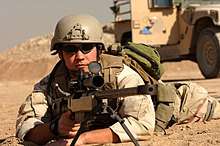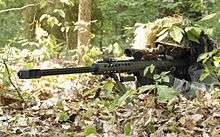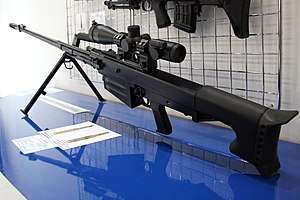Anti-materiel rifle
An anti-materiel rifle (AMR) is a rifle that is designed for use against military equipment (materiel), rather than against other combatants ("anti-personnel").

History
The origins of the anti-materiel rifle go back to the First World War, during which the first anti-tank rifles appeared. While modern tanks and most other armored vehicles are too well protected to be affected by anti-materiel rifles, the guns are still effective for attacking unarmored or lightly armored vehicles. They can also be used against stationary enemy aircraft, missile launchers, radar equipment, small watercraft, communications equipment, crew served weapons and similar targets. Their value is in being able to precisely target and disable enemy assets from long range for a relatively low cost.
Despite having been designed to be used against equipment, anti-materiel rifles have also been used for killing soldiers from distances that are beyond the effective range of rifle-caliber cartridges. Anti-materiel rifles can also penetrate most obstacles and building materials, making them viable for dispatching targets behind cover that is usually hard enough to stop rifle-caliber cartridges.
The offensive use of anti-materiel rifles or special application scoped rifles (SASR) is termed hard target interdiction (HTI) by the United States military.[1]
Anti-materiel rifles can also be used in non-offensive roles – for example, for safely destroying unexploded ordnance.
World War I

The history of anti-materiel rifles dates back to use during the First World War. The need for Anti-tank rifles was first encountered by the Germans when faced with the British Mark 1 tank. The Mark I could cross ditches up to nine-foot (2.7 m) wide, which made it a major threat to infantry in trench defenses. As a counter, the Germans first used “direct fire mortars” which were mortars aimed at low angles pointing towards enemy tanks. Later, the Germans developed the T-Gewehr anti-tank rifle, which can be credited with being the first anti-materiel rifle. The rifle was designed to penetrate the thick armor of the British tanks. The rifle weighed 41 lb (19 kg) when loaded, fired a 13.2 mm round weighing 55.5 g (1.96 oz), and had an effective range of about 1,600 ft (500 m). This weapon had a two-man crew: one to load and the other to fire the weapon, although they often switched roles. The recoil of this weapon was so high that it was known to break collar bones and dislocate shoulders. The rifle fired a steel core armor-piercing round specifically designed for the purpose of being used with this rifle.
World War II
During World War II, anti-materiel guns were widely used. The British Boys 0.55 calibre anti-tank rifle was a significant increase on the usual 0.303 calibre ammunition used by its infantry. Another weapon used was the Lahti L-39 rifle, an anti-materiel rifle designed by the Finns. One version was designed to fire a 13.2 mm cartridge and another a 20 mm cartridge. There was debate over which was more effective at piercing armor. Some argued that the smaller cartridge travelled faster and could penetrate deeper into the armor, while some believed that the higher caliber rounds would cause greater damage. The weapon weighed an incredible 109 lb (49 kg) and had an 88-inch (220 cm) barrel, and it carried the nickname "the elephant gun".
Cold War
During the Cold War the Barrett M82 rifle was produced by the United States, and was chambered to fire a .50 Browning 12.7x99 mm round. This weapon was sold by the United States to Swedish forces during the Cold War.[2]
Desert Storm
The M82 rifle first saw action in the 1990s during Operation Desert Shield and Desert Storm. The US Marine Corps initially purchased around 125 M82 rifles; orders from the Army and Air Force followed. These weapons were used with rounds such as armor piercing incendiary rounds (API) which were effective against such targets as buildings, trucks, and parked aircraft.[3] The purpose of this round was to penetrate non-armored vehicles and burst into flames on impact.
Modern day
Anti-materiel guns were used during World War I and World War II to penetrate the armor of tanks. In the modern era, the armor of tanks and other vehicles increased, making it difficult for .50 BMG bullets to penetrate. Modern day anti-materiel rifles are used to penetrate light armor vehicles or targets such as concrete barricades and buildings as well as being used to destroy unexploded ordnance. One of the most popular anti-materiel rifles today is the Barrett M107, not only for its military use but also as one of the most popular weapons available to civilians.[4] This is due to the design of the weapon, being built with a suppressor-ready muzzle brake, a thermal cheek pad, and a hand grip mounted on the inside of the rail. This rifle fires a .50 BMG caliber bullet and weighs 28.7 lb (13.0 kg), with a barrel length of 29 in (740 mm).[5] Other popular anti-materiel rifles include the Zastava M93 Black arrow, McMillan Tac-50, Gepard GM6 Lynx, AMSD OM 50 Nemesis, Accuracy International AS50, Mechem NTW-20, Istiglal IST-14.5, WKW Wilk and the CheyTac Intervention M-200.[6]
Description

Anti-materiel rifles are for use against military equipment rather than personnel. The type and size of ammunition defines a rifle as anti-materiel. When used with conventional ball or target ammunition the rifle does not have any anti-materiel capability above and beyond that of any other high velocity, large calibre rifle. The Saint Petersburg Declaration of 1868 deemed explosive rounds to be inhumane in use against personnel, but they can be employed against materiel. The size of the bullet also plays a factor in the definition. A standard rifle typically fires a 5.56mm or 7.62mm round, while anti-materiel rifles tend to fire a 12.7-mm round with the capacity for greater destruction and penetration.
In general, anti-materiel rifles are chambered for 12.7×99 mm NATO (.50 BMG), 12.7×108 mm Russian, 14.5×114 mm Russian, and 20 mm cartridges. The large cartridges are required to be able to fire projectiles containing usable payloads, such as explosives, armor-piercing cores, incendiaries, or combinations of these, as found in the Raufoss Mk 211 projectile.

The recoil produced by the cartridges employed dictates that these rifles are designed to be fired from the prone position. Bipods and monopods and muzzle brakes are used as accessories to employ these rifles as comfortably and accurately as possible. Firing several 12.7×99 mm NATO, 12.7×108 mm Russian, or larger caliber shots from the (unsupported) standing position or in a kneeling position would be very uncomfortable for the operator and can result in them being knocked over or sustaining a shoulder injury.
Two- to three-man sniper teams are required when using an anti-materiel rifle, due to its size and weight, as well as its possible range. According to the U.S. army, the range of a standard sniper rifle firing a 7.62x51 mm NATO round is a distance of about 2,600 feet (800 m) while the Barrett's effective range is 3,300 feet (1,000 m) against personnel targets, and 6,600 feet (2,000 m) against materiel targets.[7] The longest confirmed kill shot was made with a .50 BMG by a Canadian sniper in Iraq at 11,610 feet (3,540 m).[8]
List of anti-materiel rifles
The following table contains a sortable list of some anti-materiel rifles.
| Rifle | Country of origin | Caliber |
|---|---|---|
| Steyr IWS 2000 | Austria | 15.2×169mm proprietary Steyr APFSDS |
| Steyr HS .50 | Austria | .50 BMG .460 Steyr |
| Istiglal | Azerbaijan | 14.5×114mm |
| AMR-2 | China | 12.7×108mm (.50 Russian) |
| JQ | China | 12.7×108mm (.50 Russian) |
| JS 12.7 | China | 12.7×108mm (.50 Russian) |
| LR2A | China | 12.7×108mm (.50 Russian) |
| Zijiang M99 | China | 12.7×108mm (.50 Russian) .50 BMG (12.7×99mm NATO) |
| W03 | China | 12.7×108mm (.50 Russian) |
| RT-20 | Croatia | 20x110mm Hispano |
| Mambi AMR | Cuba | 14.5×114mm |
| CZW-127 | Czech Republic | .50 BMG (12.7×99mm NATO) 12.7×108mm (.50 Russian) |
| Falcon | Czech Republic | .50 BMG (12.7×99mm NATO) 12.7×108mm (.50 Russian) |
| PGM Hecate II | France | .50 BMG (12.7×99mm NATO) |
| PDSHP | Georgia | 14.5×114mm |
| Satevari MSWP | Georgia | .50 BMG (12.7×99mm NATO) |
| DSR-Precision GmbH DSR-50 | Germany | .50 BMG (12.7×99mm NATO) |
| Mauser 1918 T-Gewehr | Germany | 13.2mm TuF |
| Gepárd anti-materiel rifles | Hungary | .50 BMG (12.7×99mm NATO), 12.7×108mm (.50 Russian), 14.5×114mm Russian |
| Vidhwansak | India | 12.7×108mm (.50 Russian) 14.5×114mm 20×82mm |
| Pindad SPR-2 and SPR-3 | Indonesia | .50 BMG (12.7×99mm NATO) on SPR-2, 7.62 NATO on SPR-3 |
| Shaher | Iran | 14.5×114mm (.57 Russian) |
| Tor | Poland | .50 BMG (12.7×99mm NATO) |
| KSVK | Russia | 12.7×108mm (.50 Russian) |
| OSV-96 | Russia | 12.7×108mm (.50 Russian) |
| Zastava M93 Black Arrow | Serbia | .50 BMG (12.7×99mm NATO) or 12.7×108mm (.50 Russian) |
| Denel NTW-20 | South Africa | 14.5×114mm Russian (NTW 14.5) 20×82mm (NTW 20) 20×110mm Hispano (NTW 20) |
| Truvelo SR-20[9] | South Africa | 14.5×114mm 20×82mm 20×110mm Hispano |
| SAN 511 (formerly OM 50 Nemesis) | Switzerland | .50 BMG (12.7×99mm NATO) |
| Solothurn S-18/1000 | Switzerland | 20x138mmB |
| MKEK MAM-15 | Turkey | .50 BMG
(12.7x99mm NATO) |
| Accuracy International AS50 | United Kingdom | .50 BMG (12.7×99mm NATO) |
| Accuracy International AW50 | United Kingdom | .50 BMG (12.7×99mm NATO) |
| Accuracy International AW50F | United Kingdom | .50 BMG (12.7×99mm NATO) |
| Accuracy International AX50 | United Kingdom | .50 BMG (12.7×99mm NATO) |
| Barrett M82A1/M107 | United States | .50 BMG (12.7×99mm NATO) |
| Barrett M90 | United States | .50 BMG (12.7×99mm NATO) |
| Barrett M95 | United States | .50 BMG (12.7×99mm NATO) |
| Barrett M99 | United States | .50 BMG (12.7×99mm NATO) .416 Barrett |
| Barrett XM500 | United States | .50 BMG (12.7×99mm NATO) |
| Barrett XM109 | United States | 25×59mm |
| Anzio 20mm rifle | United States | 20x102mm Vulcan |
| Serbu Firearms BFG-50a | United States | .50 BMG (12.7×99mm NATO) .510 DTC Europ |
| Windrunner M96 | United States | .50 BMG (12.7×99mm NATO) .510 DTC Europ |
| Leader 50 A1 | United States | .50 BMG (12.7×99mm NATO) |
| Iver Johnson AMAC-1500 | United States | .50 BMG (12.7×99mm NATO) |
| McMillan Tac-50 | United States | .50 BMG (12.7×99mm NATO) |
| Desert Tech HTI | United States | .50 BMG (12.7×99mm NATO) |
See also
References
- Hard Target Interdiction, By Michael Haugen - snapshot from the Wayback Machine, dated July 19, 2007
- "Barrett M82 Anti-Tank / Anti-Material Rifle (AMR)". Retrieved 2017-11-16.
- "Barrett M82 Anti-Tank / Anti-Material Rifle (AMR)". Retrieved 2017-11-16.
- "Barrett M107 Heavy Caliber Anti-Material / Anti-Personnel Sniper Rifle". Retrieved 2017-11-16.
- "M107A1 | Barrett". barrett.net. Retrieved 2017-11-16.
- "The Top 10 Anti-Material Sniper Rifles in the World?". funkertactical.com. Retrieved 2017-11-16.
- "Small Arms – Precision Weapons". United States Army Acquisition Support Center (USAASC). Retrieved 2018-04-25.
- "A Canadian sniper breaks the record for the longest confirmed kill shot – }but how?". BBC Newsbeat. 2017-06-23. Retrieved 2018-04-25.
- "Sniper Rifles". Archived from the original on 2010-04-03.
External links
| Wikimedia Commons has media related to Anti-materiel rifles. |
